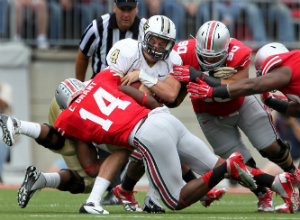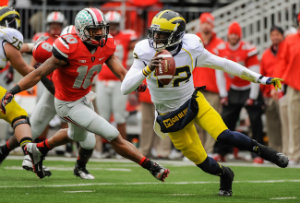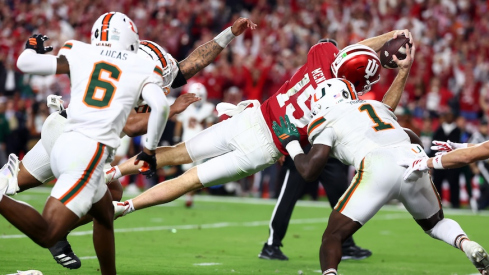Two weeks ago I took a look at three different efficiency metrics for offenses – yards per point, yards per play, and points per play – and studied how the Buckeyes did according to each statistic in 2012.
 Curtis Grant and the linebackers will need to step up in 2013
Curtis Grant and the linebackers will need to step up in 2013The Buckeyes were among the best in the country in terms of offensive yards per point and points per play, but in the mid-thirties for yards per play.
While there is certainly a debate over which statistic is most important for capturing efficiency, I felt that it was necessary to view the three side by side in order to get the full picture of the 2012 offense. Primarily, Braxton and company were fairly efficient in their drives, but didn't always rack up tons of yards.
Before diving in to the defensive statistics, here's a quick refresher on the three metrics.
Yards per point is highly correlated with red zone efficiency – teams that score touchdowns instead of field goals – but is susceptible to turnovers and varies significantly throughout the course of the season.
Yards per play is not affected by turnovers, but also doesn't capture points. It doesn't matter if the offense had a 99 yard drive if the drive ends with an interception at the one yard line.
Finally, a team with a high points per play is able to minimize negative plays while still scoring touchdowns more often than field goals. It is closely related to yards per point.
So how did the Buckeyes perform on defense in 2012?
| Opp Yards per point | Opp yards per play | Opp Points per play | |
|---|---|---|---|
| 2012 Defense | 15.8 (35th) | 5.08 (28th) | 0.312 (28th) |
While there was a fairly large difference between the three metrics for the offense, the defensive rankings are much more similar.
The defense, as expected, was good but not great according to these three metrics. For instance, the Buckeyes' .312 opponent points per play is far off from the stellar 2009 defense, which averaged .19 opponent points per play.
 Shazier, Barnett, and Bryant will lead an efficient defense
Shazier, Barnett, and Bryant will lead an efficient defenseThere was far more stability across the three metrics for all teams, not just Ohio State. Alabama, Notre Dame, and Florida were among the top for each metric.
Furthermore, the defensive efficiency metrics appear to be highly correlated with overall success – much more so than for the offensive efficiency metrics. Alabama and Notre Dame are the top two overall teams according to both opponent yards per play and opponent points per play.
The Buckeyes' defensive efficiency was steady under much of Tressel's tenure, then dropped suddenly with his departure in 2011. While coaching and scheme changes are partly to blame, it's hard for me to ignore the impact of losing great linebackers as well. Better linebacker (and Star) play will be crucial in 2013 for covering slot receivers, providing additional pressure on quarterbacks, and thwarting the run game.
It is likely that the opponent yards per point ranking is lower than the other two metrics because the Buckeye defense created fewer turnovers than other elite defenses.
I've mentioned before that the Buckeyes should emphasize creating turnovers, but the problem is that turnovers are often completely random and unrelated to the quality of the defense as a whole.
If the Buckeyes' lower yards per point ranking can mostly be explained by a low number of forced turnovers, then we are left with a fairly clear picture of the 2012 defense – good, but not great, and certainly not up to the later Tressel/Heacock standards. The good news with that is that the secondary will be full of veteran players, the linebacking core finally has some quality (if unproven) depth, and the defensive line is a row of four- and five-star recruits.
Urban won't be satisfied with a mediocre defense in 2013, but will insist that the defense match the offense's efficiency.

